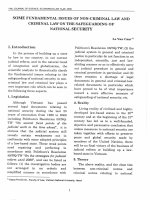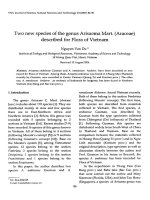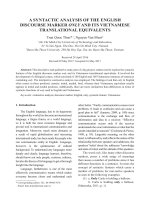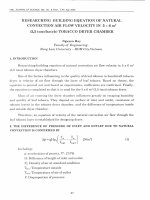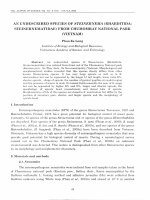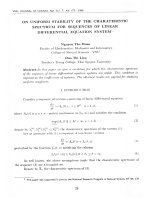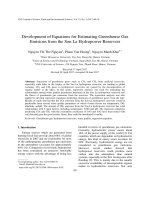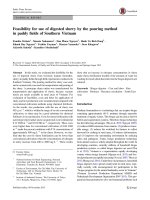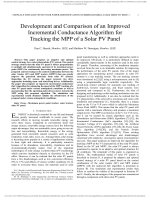DSpace at VNU: Feasibility for use of digested slurry by the pouring method in paddy fields of Southern Vietnam
Bạn đang xem bản rút gọn của tài liệu. Xem và tải ngay bản đầy đủ của tài liệu tại đây (1.15 MB, 10 trang )
Paddy Water Environ
DOI 10.1007/s10333-015-0512-0
TECHNICAL REPORT
Feasibility for use of digested slurry by the pouring method
in paddy fields of Southern Vietnam
Fumiko Oritate1 • Masato Nakamura1 • Dan Phuoc Nguyen2 • Hanh Vu Bich Dang2
Khanh Duy Nguyen2 • Yoshito Yuyama1 • Masaru Yamaoka1 • Iwao Kitagawa1 •
Akiyoshi Sakoda3 • Kazuhiro Mochidzuki3
•
Received: 13 August 2014 / Revised: 8 October 2015 / Accepted: 2 November 2015
Ó The International Society of Paddy and Water Environment Engineering and Springer Japan 2015
Abstract In this study, we evaluated the feasibility for the
use of digested slurry from livestock manure (hereafter,
slurry) in paddy fields through field experiments conducted in
Southern Vietnam. The pouring method for slurry was used,
and a vacuum truck was used for transportation and pouring of
the slurry. A prototype slurry tanker was manufactured for
transportation and application of slurry, because vacuum
trucks are rarely available in rural areas of Vietnam. For
evaluation of feasibility, costs and labor for application of
slurry and rice production were examined and compared with
conventional cultivation methods using chemical fertilizers.
As the results, rice production with the use of slurry was
485 g m-2, which is within the range of on-site conventional
cultivation, so slurry may be a good substitute for chemical
fertilizers in rice production. Costs for slurry fertilization with
a prototype slurry tanker and a vacuum truck were estimated at
0.13 USD m-2 and 0.10 USD m-2, respectively. These costs
were higher than for conventional cultivation of 0.06 USD
m-2 under the present conditions with T-N concentrations of
approximately 400 mg L-1 in the slurry. However, we clarified that the cost for slurry fertilization can be lower than
conventional cultivation when the concentrations of nitrogen
in slurry increase from 400 to 2000 mg L-1. These results
& Fumiko Oritate
1
National Institute for Rural Engineering, National
Agriculture and Food Research Organization, 2-1-6
Kannondai, Tsukuba-shi, Ibaraki 305-8609, Japan
2
Faculty of Environment, Ho Chi Minh City University of
Technology, 268 Ly Thuong Kiet Street, District 10,
Ho Chi Minh City, Vietnam
3
Institute of Industrial Science, The University of Tokyo,
4-6-1 Komaba, Meguro-ku, Tokyo 153-8505, Japan
show that an increase in nitrogen concentrations in slurry
make slurry fertilization feasible if the amounts of water for
washing livestock sheds that enter into the biogas digesters are
reduced.
Keywords Biogas digester Á Cost and labor Á Rice
cultivation Á Biomass Á Resource circulation Á South East
Asia
Introduction
Methane fermentation is a technology that can acquire biogas
containing approximately 60 % methane through anaerobic
treatment of organic wastes. This biogas can be used as fuel for
boilers and cogeneration systems. Therefore, biogas technology
has the following advantages (Thu et al. 2012; Nguyen 2005):
(1) reduces GHG emissions from manure, (2) produces renewable energy, (3) reduces the workload for farmers to collect
firewood for cooking in rural areas, (4) reduces deforestation,
and (5) improves the surrounding environment by reducing
odors and pathogens. Today, biogas production technology
from animal wastes is widely adopted throughout the world. In
developing countries, currently millions of household biogas
production systems, so called biogas digesters are used (Thu
et al. 2012). Vietnam is a representative rapidly developing
country where energy demands (Nguyen et al. 2013) and livestock production are rapidly increasing (Vu et al. 2007; Thu et al.
2012; Huong et al. 2014). Under these circumstances, household
biogas digesters have spread countrywide in rural areas, especially recently with encouragement for participation in the
‘‘biogas program for the animal husbandry sector in Vietnam’’
(Vietnam Livestock Production Department MARD and
Netherlands Development Organization SNV 2013). This program has been promoted to solve environmental problems such
123
Paddy Water Environ
as air and water pollution caused by livestock manure, and to
provide a clean and affordable energy source for the local people
(Thu et al. 2012; Vietnam Livestock Production Department
MARD and Netherlands Development Organization SNV
2013). Problems are that most slurry from biogas digesters is
discharged to water bodies without any treatment, and small
amounts are used as fertilizer for garden trees or vegetables in
fields adjacent to farmer houses and as feed for fishes (Thu et al.
2012; Huong et al. 2014). Slurry deteriorates the water quality in
water bodies because slurry contains large amounts of nitrogen,
at least more than 250 mg L-1 of total kjeldahl nitrogen (Oritate
et al. 2015). The authors propose utilizing slurry as a fertilizer in
paddy fields. This proposal is an effective option to conserve the
water environment because Vietnam has large paddy areas
(General Statistics Office Vietnam 2011). The utilization of
slurry in paddy fields also requires transportation of slurry from
the biogas digesters to the fields (Thu et al. 2012) and application
to the fields. As a transportation method, vacuum trucks are
popular and usually used in Japan (Yamaoka et al. 2012). There
are three methods for application of slurry to the paddy fields,
i.e., pouring with irrigation water from an inlet using a vacuum
truck, spreading on the soil surface with a slurry spreader, and
injecting into the soil with a slurry injector (Watanabe et al.
2011). The pouring method is applicable after irrigation and
during rice growth for additional fertilization (Phayom et al.
2012). The methods for application with a spreader and injector
are applicable for basal fertilization before planting (Iida et al.
2009). Spatial distribution of slurry focusing on nitrogen applied
to a field by the pouring method has been studied by numerical
analyses (Yuge et al. 2014; Inomura et al. 2010). A possibility to
obtain the same or better yield with the use of slurry by the
pouring method as by conventional cultivation with chemical
fertilizers has been shown through actual field studies (Koga
et al. 2010; Mihara et al. 2011). Detailed procedures for the
pouring method were compiled by Iwashita et al. (2008) as
follows: (1) decrease the surface water of the field to shallow
ponding conditions, namely a water level of 0 cm (Koga et al.
2010) or 0.3 cm (Mihara et al. 2011), before application of
slurry, (2) pour slurry with a specific volume of irrigation water,
an irrigation water level of 4–5 cm (Mihara et al. 2011) in the
field after finishing the pouring of the slurry with irrigation
water, (3) dig a trench when there is a shortage of irrigation
water, and (4) improve the land level by careful paddling.
The authors considered the pouring method as applicable in Vietnam because it requires fewer machines than
other methods. The objective of this study was to evaluate
the feasibility for use of slurry in paddy fields, and we
tested the pouring method in a village of Southern Vietnam. A prototype slurry tanker was manufactured because
vehicles for transportation of slurry are rarely available in
rural areas of Vietnam. Rice yield, costs, and labor with the
pouring method were measured and compared with conventional cultivation in the same area.
123
Materials and methods
Digested slurry used for this study
There were approximately 111 small scale biogas digesters
with fermentation tank capacities of 7.8 ± 1.2 m3 in the
study area (Oritate et al. 2015). Digested slurry for the
experiments was taken from household scale biogas
digesters of two pig farms for each fertilization in Thai My
Village. The distance between the experimental field and
pig farms was 5.3 km. Each location is shown in Fig. 1.
The digesters ferment pig manure and pig pen washing
water at air temperature. Properties of the slurry are shown
in Table 1. Because large volumes of washing water enter
the biogas digesters, nitrogen concentrations in the slurry
are lower when compared to ordinary slurry in Japan with a
range of 1000–3000 mg L-1 of total nitrogen (T-N)
(Nakamura et al. 2012).
Prototype slurry tanker
Vehicles for slurry transportation are rarely available in
rural areas of Vietnam. Therefore, an original prototype
slurry tanker was manufactured with assemblage of a 3 m3
plastic tank, tractor trolley, motor pump, and generator.
Details including dimensions, specifications, and price of
the equipment are shown in Table 2. Total cost of the
prototype slurry tanker was 3,554 USD. This cost does not
include the cost for assemblage because farmers can do it
themselves. Materials are commonly available on-site. The
prototype slurry tanker was towed with a 55 HP (horsepower) tractor. Tractors are usually rented for farm work in
the village. The rental fee for a tractor with an operator is
23.85 USD half-day-1 (half-day indicates 4 h). Appearance
of the prototype slurry tanker and tractor is shown in Fig. 2.
Experimental field
Experiments were conducted in 300 m2 plots as shown in
Fig. 3, set with plastic sheets in a paddy field of Binh Ha
Dong, Thai My Village, Cu Chi District, Ho Chi Minh City
(10°590 197800 N 106°220 085700 E), approximately 43 km
north-west from the center of Ho Chi Minh City (Fig. 1). In
this village, pig farming and rice cultivation are common.
A control plot was also set outside the experimental plot
shown in Fig. 3 and was conventionally cultivated using
chemical fertilizers.
Areas containing the experimental fields were located in
low-lying lands and rice cultivation conducted twice a year
in most paddy fields. The soil was TypicSulfaquepts
(USDA 2010). Main properties of the soil in the experimental fields were: pH of 3.93, EC of 0.16 mS cm-1, T-N
Paddy Water Environ
Vietnam
Laos
South
China
Sea
Cambodia
Thai My Village
Ho Chi Minh
City
Legend
Canals and rivers
Main roads
Lands for paddy field
Lands for perennial culture
Lands for perennial orchard
Residential area and lands for annual culture
Pig farms
Experimental field
Pig farms (slurry supply in this experiment)a
Route of the tractor (5.3 km)
Fig. 1 Location of the experimental field, the biogas digesters, and pig farms in Thai My Village. aLocation of pig farms refer to Vision Tech
Inc. (2011)
Table 1 Properties of slurry and irrigation water
pH
The second additional
fertilization (10 May)
The third additional
fertilization (31 May)
a
EC (S m-1)
T-Na
(mg L-1)
Slurry
–
–
472
Canal water
–
–
11
NH4-N
(mg L-1)
NO3-N
(mg L-1)
PO4-P
(mg L-1)
K?
(mg L-1)
305
–
–
–
2
–
–
–
Slurry applied by 1st shuttle
7.3
0.39
312
255
\0.01
28.7
192
Slurry applied by 2nd shuttle
7.0
0.33
264
243
\0.01
30.5
171
Canal water
5.7
0.01
12
N.D.
\0.01
N.D.
–
Values for T-N in this table are actually for total kjeldahl nitrogen (TKN), but the values of NO3-N are negligible as shown above
N.D. not-detected (less than 0.2 mg L-1)
of 3.9 g kg-1, total carbon (T-C) of 49.4 g kg-1, ammonia-nitrogen (NH4-N) of 1.81 mg 100 g-1, and less than
0.1 mg 100 g-1 of nitrate-nitrogen (NO3-N).
Cultivation schedule and fertilization method
Experiments were conducted during the rainy season from
April to July 2013. Rice cultivar was ‘‘OM6976’’ and
sowed directly in the flooded field on 12 April 2013. Fertilization was conducted as shown in Table 3. Schedules
and rates of each chemical fertilizer application were based
on on-site conventional cultivation. First and second
additional fertilizations were conducted when rice was in
the tillering stage, and the third additional fertilization was
done just before the booting stage. Fertilization dates and
nitrogen application rates for the experimental plot were
123
Paddy Water Environ
Table 2 Equipment used for pouring slurry
Machine/
equipment
Machine model
HP
Fuel
variety
Application
Dimension capacity/specifications
Initial investment
cost (USD)a
Stocking slurry
Overall dimension:
(H) 1270 9 (W) 1360 9 (L) 2280 (mm)
143
(a) Equipment for prototype slurry tanker
Plastic tank
–
–
–
Total capacity: 3 m3
(Available capacity: 2.7 m3)
Tractor
trolley
–
–
–
Loading tank
Overall dimensions: (W) 1500 9 (L) 2800
(mm)
1,670
Tire size: (/) 825 9 (W) 160 (mm)
Motor
pump
PENTAX
DX100/2G
1.75
–
Collection and
pouring of slurry
Characteristic curve
Q
0
6
12
18
H
9.8 8.3 6.3 3.5
Q: Quantity (m3 h-1), H: Head (m)
372
Generator
HONDA HG
7500 SE
13
Gasoline
Collection and
pouring of slurry
220 V, 6.0 kW, equipped with the engine
of HONDA GX390
1,369
Initial investment cost for prototype slurry tanker (Total of above equipment costs)
Machine/
equipment
Machine
model
3554
HP
Fuel
variety
Use application
Remarks
Cost (USD)
(b) Other equipment
Tractor
FORD
4000
55
Diesel
oil
Traction of prototype slurry tanker
Rental fee of a tractor for half-dayb
23.85
Vacuum
truck
–
–
Diesel
oil
Collection, transportation and
pouring of slurry
Rental fee of vacuum truck for 1 dayc
71.55
Engine pump
B80NT
Gasoline
Pouring irrigation water into the
fieldd
5.5
Available capacity of tank of vacuum
truck:5.5 (m3)
Equipped with a HONDA GX160
engine
Owned by
farmers
HP horsepower of machine
a
b
Data for the costs of equipment were obtained by on-site interviews of farmers and villagers
Rental fee for a tractor including operation and maintenance costs, fuel cost, and labor cost for 1 operator. ‘‘Half day’’ indicates 4 h
c
Rental fee for a vacuum truck including operation and maintenance costs, fuel cost, and labor cost for 2 operators. ‘‘1 day’’ indicates 8 h
d
Engine pump prepared not only for the irrigation with slurry fertilization, but used for ordinary general agricultural works
exactly the same as the control, but the first additional
fertilization on 25 April 2013 was postponed because the
rice plants were too small. Therefore, application for the
first additional fertilization was distributed with the second
and the third additional fertilizations. An estimated T-N of
400 mg L-1 in the slurry was used to calculate the application rate of nitrogen for the experimental plot. The actual
nitrogen application rates are as shown in Table 3 based on
the nitrogen concentrations in slurry shown in Table 1.
For both the second and the third additional fertilizations
for the experimental plot, slurry was applied with irrigation
water from the road side of the field as shown in Fig. 3.
The second additional fertilization was conducted with a
vacuum truck. A vacuum truck is ordinarily used for the
collection and transportation of sludge from septic tanks of
households. The truck had a capacity of 5.5 m3 of slurry as
shown in Fig. 4 and Table 2.
123
The third additional fertilization was conducted with the
prototype slurry tanker used for transportation and application of slurry.
Harvest was conducted on 21 July for the control plot
and 26 July for the experimental plot.
Survey and analysis
At the third additional fertilization day on 31 May 2013,
working procedures needed for pouring slurry, time, fuel,
and costs consumed for each procedure during fertilization
were recorded. Data of labor costs for agricultural activities, price, and components of each chemical fertilizer used
for conventional cultivation and fuel prices were obtained
by interviews of farmers and villagers. Cost and labor for
the prototype slurry tanker during the second additional
Paddy Water Environ
Fig. 2 Photograph of the
prototype slurry tanker and
tractor for towing. aPrototype
slurry tanker manufactured by
assemblage of plastic tank,
tractor trolley, generator, and
pump. bTractor rented every
time for fertilization
Pump and generator
Plastic tank
Tractor trolley
Prototype slurry tankera
Road
Pouring point for
slurry and water
Tractorb
Results and discussion
Rice production with the use of slurry by pouring
method
Irrigation and
drainage canal
300 m2
Control plot
Experimental
plot
6000 m2
Yield and yield components for the experimental and
control plots are shown in Table 4. Yield in the experimental plot was 485 g m-2, within the range of
300–500 g m-2 for on-site conventional cultivation (Oritate et al. 2015) and yield for Ho Chi Minh City was
392 g m-2 (General Statistics Office Vietnam 2011).
However, a yield of 299 g m-2 for the control plot was
lower than the values for on-site conventional cultivation.
According to the ears per 1 m2, plant height and nitrogen
concentration of rice grain (Table 4), rice growth in the
control plot appeared delayed with excess nitrogen. Rice
production in the experimental plot showed that slurry can
be substituted as the chemical fertilizer for rice production.
Work procedures, fuel consumption, and labor
for slurry application
Fig. 3 Diagram of experimental field
fertilization were estimated from data from the experimental plot at the third additional fertilization.
At harvest, yield and yield components such as height of
plants, numbers of ears per 1 m2, numbers of grains per 1 ear
were measured, and total nitrogen content of rice grains analyzed with a NC-Analyzer (SUMIGRAPH NC-220, SCAS).
Total nitrogen content of rice plants was analyzed with a NCAnalyzer (Euro EA 3000, Euro Vector).
During cultivation, precipitation was recorded with a
rain gage (OW-34-BP, Ota Keiki) equipped with a data
logger (UIZ3639, UIZIN).
Slurry needed for the second and third additional fertilizations of the experimental plot were 5.0 and 3.26 m3,
respectively. Slurry was transported by 2 shuttles of the
prototype slurry tanker (available capacity of 2.7 m3) for
the third additional fertilization and 1 vacuum truck for the
second additional fertilization (available capacity of
5.5 m3). Slurry was collected from biogas digesters of pig
farms in Thai My Village. Slurry and irrigation water were
applied based on previous studies (Koga et al. 2010;
Mihara et al. 2011; Kamioka and Kamewada 2011; Iwashita et al. 2008). At both additional fertilizations, slurry
and irrigation water were poured together until the increase
of 4–5 cm of water level. Water level could not be
123
Paddy Water Environ
Table 3 Fertilization design for field experiment
Fertilization
Experimental plot
Control plot
Application rate for slurry
(m3 m-2)
Application rates for N, P2O5 and K2O as slurry
Application rates for N, P2O5 and K2O as
chemical fertilizersa
N (g m-2 as T-N)
N (g m-2)
P2O5 (g m-2) K2O (g m-2)
P2O5 (g m-2)
K2O (g m-2)
First (25 April)
–
0.0
0.0
0.0
4.6
8.0
0.0
Second (10 May)
1.67 9 10-2
7.9
1.9b
6.0c
4.0
4.0
3.0
Third (31 May)
1.09 9 10-2
3.1
0.7
2.4
2.0
2.0
3.9
Total
2.76 9 10-2
11.0
2.6
8.4
10.6
14.0
6.9
a
Variety and rate of chemical fertilizers applied on each fertilization day were as follows
(1) Urea of 10 g m-2 and phosphorus fertilizer of 50 g m-2 applied on 25 April 2013
(2) Mixed fertilizer of N: P2O5: K2O = 20: 20: 15 for 20 g m-2 applied on 10 May 2013
(3) Mixed fertilizer of N: P: K = 20: 20: 15 of 10 g m-2 and potash fertilizer of 4 g m-2 applied on 31 May 2013
b
Data of phosphate concentrations in slurry used for second additional fertilization could not be obtained. Therefore, rate was calculated based
on the ratio of phosphate concentrations to total nitrogen concentrations for the third additional fertilization
c
Data of potassium concentrations in slurry used for second additional fertilization could not be obtained. Therefore, rate was calculated based
on the ratio of potassium concentrations to total nitrogen concentrations for the third additional fertilization
in Fig. 5. Pouring rate of slurry was 2.98 L s-1 for the
second additional fertilization and 4.62 L s-1 for the third
additional fertilization as shown in Table 5. Pouring rate of
slurry that we used was faster than the 2.3 L s-1 of Mihara
et al. (2011) and 0.48 L s-1 of Kamioka and Kamewada
(2011). Irrigation water was poured at a rate of 6.07 L s-1
even though Kamioka and Kamewada (2011) used a rate of
3.3 L s-1. Both pouring rates in this study were based on
the capacity of each pump.
One worker and one operator for the tractor and two
operators for the vacuum truck were engaged for collection, transportation and pouring of the slurry, and one
worker took charge of the pouring of irrigation water. The
fuel consumption rate, fuel price, and labor costs are shown
in Table 5.
Fig. 4 Photograph of vacuum truck
decreased to shallow ponding conditions proposed by
Iwashita et al. (2008) for the second additional fertilization.
Field conditions before application of slurry were dryer
than the conditions proposed by Iwashita et al. (2008) for
the third additional fertilization, because of poor irrigation
and drainage conditions in the paddy field, and low precipitation before the third additional fertilization as shown
Work procedures, fuel consumption, and labor
for application of chemical fertilizer
Chemical fertilizers were manually applied by workers. The
time required for fertilization based on the weight of chemical
fertilizers was 6.08 9 10-2 h kg-1 person-1. Application
Table 4 Yield and yield components in experimental plot and control plots
Experimental
plot
Control plot
123
Yield
(g m-2)
Ears per 1 m2
(n m-2)
Grains per 1 ear
(n ear-1)
Plant height
(cm)
Nitrogen content of
rice grain (%)
Nitrogen content of rice
plants (%)
Average
485
(n = 12)
232 (n = 12)
63 (n = 120)
83.3
(n = 119)
1.8 (n = 12)
4.9 (n = 12)
SD
187
107.6
24.9
10.7
0.3
0.6
Average
299
(n = 3)
483 (n = 3)
32 (n = 30)
91.8
(n = 30)
1.9 (n = 1)
3.0 (n = 3)
SD
–
101.9
22.7
12.5
–
0.5
Paddy Water Environ
Fig. 5 Precipitation during
cultivation
The third additional fertilization
Harvesting experimental plot
Precipitation (mm/d)
80
60
Harvesting
control plot
The first The second
additional additional
Seeding fertilization fertilization
40
20
0
4/1
4/11
4/21
5/1
5/11
5/21
5/31
6/10
6/20
6/30
7/10
7/20
Month/data
(2013)
Table 5 Data obtained for slurry fertilization
No.
Category
Factor
Data
(a) Data common to slurry fertilization for prototype slurry tanker and vacuum truck
1
Price
2
Labor costs for agricultural work
1.19 (USD h-1 person-1)
Gasoline price (Average price in May 2013)
1.06 (USD L-1)
3
Collection of
slurry
Time for preparation and withdrawal for collection of slurry
900 (s shuttle-1)a
4
Pouring of slurry
Time for preparation and withdrawal for pouring of slurry
900 (s shuttle-1)
5
Pouring of
irrigation
water
Flow rate for pouring of irrigation water with engine pump
6.07 (L s-1)
Fuel consumption rate for engine pump during irrigation
Time for preparation and withdrawal of irrigation water
8.91 9 10-4 (L s-1)
900 (s)
Time for monitoring water level
20 % of the running time
of an engine pump
6
7
8
(b) Data for slurry fertilization with prototype slurry tanker
1
Price
Rental fee of a tractor for half-day (with one operator)
23.85 (USD 4 h-1)
2
Transportation
Driving speed of a tractor (20 min required for transportation of 5.3 km)
0.265 (km min-1)
3
Flow rate for collection of slurry with a motor pump on the prototype slurry tanker
3.08 (L s-1)
4
Collection of
slurry
9.94 9 10-4 (L s-1)
5
Pouring of slurry
Fuel consumption rate for generator on the prototype slurry tanker to drive the motor
pump for collection and pouring of slurry (Value is same for pouring of slurry)
Flow rate for pouring slurry with motor pump on the prototype slurry tanker
4.62 (L s-1)
(c) Data for slurry fertilization with a vacuum truck
a
1
Price
Rental fee of a vacuum truck for 1 day (with two operators)
71.55 (USD 8 h-1)
2
Transportation
Driving speed of a vacuum truck (Tractor speed was used)
0.265 (km min-1)
3
Collection of
slurry
Flow rate for collection of slurry with vacuum truck
4.17 (L s-1)
4
Pouring of slurry
Flow rate for pouring slurry with vacuum truck
2.98 (L s-1)
‘‘Shuttle’’ indicates the shuttle between the field and the biogas digester for slurry fertilization
rate for each fertilizer on each fertilization day was as shown
in the notes under Table 3. The prices of fertilizers used for
the control plot were surveyed. A motor-cycle was used for
transportation of chemical fertilizers from the farmer’s house
to the field. Maximum weight of the chemical fertilizer
transported by the motor-cycle was 50 kg. Ten minutes and
0.17 L of gasoline were consumed for transportation of 1
shuttle from the farmer’s house to the experimental field. The
plot was irrigated before application of chemical fertilizer for
the third additional fertilization, because the surface of the
field was dry. Data obtained are shown in Table 6.
Estimation of cost for fertilization
Cost for slurry fertilization was estimated based on data
obtained from the experiments to evaluate the feasibility of
123
Paddy Water Environ
Table 6 Data obtained for fertilization in conventional cultivation with chemical fertilizer
No.
Category
Factor
Data
1
Price
Labor costs for agricultural work
1.19 (USD h-1 person-1)a
2
Gasoline price (Average price in May 2013)
1.06 (USD L-1)a
3
Mixed fertilizer of NPK
0.72 (USD kg-1)
4
Urea
0.48 (USD kg-1)
5
Phosphorus fertilizer
0.14 (USD kg-1)
6
Potash fertilizer
0.50 (USD kg-1)
10 (min)
8
Time for transportation between the field and farmer’s house with a
motor-cycle
Fuel consumption rate of a motor-cycle
9
Maximum weight of chemical fertilizer transported with a motor-cycle
50 (kg shuttle-1)
7
Transportation
1.7 9 10-2 (L min-1)
10
Application
Time for fertilization per weight of chemical fertilizer and per number
of workers
6.08 9 10-2 (h kg-1 person-1)
11
Pouring of irrigation
water in the field
Flow rate for pouring irrigation water with the engine pump
6.07 (L s-1)a
Fuel consumption rate for engine pump during irrigation
8.91 9 10-4 (L s-1)a
13
Time for preparation and withdrawal for pouring of irrigation water
900 (s shuttle-1)a
14
Time for confirmation of irrigation conditions
20 % of the running time
of the engine pump
12
a
Data is same as for slurry fertilization
Cost (USD m-2)
0.15
0.10
0.05
0.00
Chemical
fertilizer
Prototypea
400 mg L-1
Rental fee of tractor / vacuum truck
Maintenance and repair cost of prototype
slurry tanker
Cost for collection of slurry
Prototypeb
2,000 mg L-1
Vacuumc
400 mg L-1
Cost for chemical fertilizer
Cost for transportation
Cost for application of slurry / chemical
fertilizer
Vacuumd
2,000 mg L-1
Depreciation cost of prototype slurry
tanker
Cost for irrigation
Fig. 6 Cost comparisons for fertilization. a ‘‘Prototype 400 mg L-1’’
indicates slurry fertilization with the prototype slurry tanker at a
nitrogen concentration of 400 mg L-1. b ‘‘Prototype 2,000 mg L-1’’
indicates slurry fertilization with the prototype slurry tanker at a
nitrogen concentration of 2,000 mg L-1. c ‘‘Vacuum 400 mg L-1’’
indicates the slurry fertilization with the vacuum truck at a nitrogen
concentration of 400 mg L-1. d ‘‘Vacuum 2,000 mg L-1’’ indicates
slurry fertilization with the vacuum truck at a nitrogen concentration
of 2,000 mg L-1
slurry fertilization from the viewpoint of economics. The
estimation conditions were set as follows.
(1) Application schedule and rates of fertilization are
shown in Table 3.
(2) Transportation distance was 2.5 km
Although the distance was 5.3 km to the experiment
plot, this distance was reduced to 2.5 km according to the
distribution of paddy fields and pig farms in the village as
shown in Fig. 1.
(3) T-N in the slurry was 400 or 2000 mg L-1
T-N of approximately 400 mg L-1 was the average
value obtained in our previous study (Thang et al. 2011).
T-N of 2000 mg L-1 is a proposed value. Reduction of
washing water for livestock sheds into the biogas
123
Paddy Water Environ
digesters is expected to reach the plan value of
2000 mg L-1.
(4) Surface water levels in the field before and after
application of slurry and irrigation water were 0 and 4 cm,
respectively.
Surface water levels before and after slurry fertilization
were set at 0 cm and 4 cm for the third additional fertilization even though the experiments were conducted during the rainy season. Surface of the field at the third
additional fertilization was dry. Therefore, surface water in
the field can be assumed to be almost as dry as the third
additional fertilization.
The estimation is summarized in Fig. 6. Costs for fertilization by conventional cultivation with chemical fertilizer was estimated as 0.06 USD m-2. However, slurry
fertilization with the prototype slurry tanker cost 0.13
USD m-2 and slurry fertilization with a vacuum truck
cost 0.10 USD m-2 under the current situation of T-N of
400 mg L-1 in the slurry. The increase in T-N in the
slurry from 400 to 2000 mg L-1 drastically reduced the
costs for slurry fertilization. Costs for slurry fertilization
with both the vacuum truck and the prototype slurry
tanker were lower than the costs for chemical fertilizers.
Costs for slurry fertilization with a vacuum truck were
lower than the costs with the prototype slurry tanker,
because the vacuum truck can transport larger volumes of
slurry at one time. However, the use of prototype slurry
tankers to transport slurry can be economical because
vacuum trucks are rarely available in rural areas of
Vietnam.
These results show that an increase in slurry nitrogen
concentrations by a reduction in the entry of washing water
from livestock sheds into the biogas digesters make slurry
fertilization feasible.
Conclusions
In this study, slurry was applied by the pouring method as
additional fertilizer to evaluate the feasibility of the use of
slurry in paddy fields of Southern Vietnam. Data-related
costs and labor for application of slurry and rice production
by this method were obtained and compared with applications of chemical fertilizers.
Rice production with the use of slurry was 485 g m-2,
which is within the range of on-site conventional cultivation with chemical fertilizers. Therefore, we showed that
slurry can be substituted for chemical fertilizers for rice
production.
T-N concentrations from 400 to 2000 mg L-1 in the
slurry showed that the cost for slurry fertilization can be
reduced to less than the cost for chemical fertilizers.
A reduction in washing water can produce nitrogen
concentrations of 2000 mg L-1 in the slurry.
Our experiments and estimations clarify the feasibility
of slurry fertilization in Southern Vietnam. We believe the
information in this report can contribute to the promotion
of slurry utilization in South East Asia.
Acknowledgments This study was supported by JST-JICA
SATREPS ‘‘Sustainable Integration of Local Agriculture and Biomass Industries.’’ The authors are thankful to Dr. Shigeo Ogawa of
the National Institute for Rural Engineering, National Agriculture
Food Research Organization for providing valuable information about
distribution of pig farms in Thai My Village.
References
General Statistics Office Vietnam (2011) Statistical yearbook of
Vietnam 2011. Statistical Publishing House, Hanoi
Huong LQ, Madsen H, Anh LX, Ngoc PT, Dalsgard A (2014)
Hygienic aspects of livestock manure management and biogas
systems operated by small-scale pig farms in Vietnam. Sci Total
Environ 470–471:53–57. doi:10.1016/j-scitotenv.2013.09.023
Iida M, Ohdoi K, Ryu C, Umeda M (2009) Basal application of
methane fermentation digested liquid using a slurry injector.
J Jpn Soc Agric Mach 71(2):81–87 (in Japanese)
Inomura K, Yuge K, Anan M, Shinogi Y (2010) Numerical analysis
of anaerobically digested slurry with irrigation water in rice
paddy. J Fac Agric Kyushu Univ 55(2):357–363. doi:10.1007/s1033-013-0382-2
Iwashita K, Fukushi K, Sugita H, Yuge K, Tanaka M, Nakano Y
(2008) Establishment of rural resource recycling through the
effective application of digested slurry from methane fermentation system to paddy and upland fields. Jpn Soc Irrig Drain Rural
Eng 4:55–70 (in Japanese with English abstract)
Kamioka H, Kamewada K (2011) Effect of anaerobically digested
cattle slurry as basal application on paddy rice Koshihikari. Jpn J
Soil Sci Plant Nutr 82:31–40 (in Japanese with English
abstract)
Koga Y, Matsuo M, Terao H, Ogawa T, Hoyoshi K, Kagehigashi S,
Kurogi Y, Nishiwaki A (2010) Effects of anaerobically digested
slurry to the growth and yield of rice. Bull Fac Agric Univ
Miyazaki 56:15–27 (in Japanese with English abstract)
Mihara M, Hyakutake C, Ijichi T, Mori N (2011) Fertilizer use of
digestive fluids from biogas-plant in rice cultivation. Rep
Kyushu Br Crop Sci Jpn 77:15–18 (in Japanese)
Nakamura M, Yuyama Y, Yamaoka M, Oritate F, Fujikawa T (2012)
Method for utilization of methane fermented digested slurry as a
liquid fertilizer to minimize negative environmental impacts. Jpn
Soc Irrig Drain Rural Eng 8:11–30 (in Japanese with English
abstract)
Nguyen QC (2005) Dairy cattle development: environmental consequence and pollution control option in Hanoi province, North
Vietnam. Research Report No. 2005-RR2006. Published by the
Economy and Environment Program for Southeast Asia (EEPSEA), Singapore
Nguyen KT, Nguyen HH, Doan TH, Tran DM (2013) Biomass
potentials in Vietnam; current status and prospects for biofuel
development. J Jpn Inst Energy 92:99–105
Oritate F, Yuyama Y, Nakamura M, Yamaoka M, Nguyen PD, Dang
VBH, Mochidzuki K, Sakoda A (2015) Regional diagnosis of
biomass use in suburban village in Southern Vietnam. J Jpn Inst
Energy 94:805–829
123
Paddy Water Environ
Phayom W, Iwashita K, Iwata M, Tanaka M (2012) Study of a slurry
irrigation system by methane fermentation digestion for wet rice
cultivation. EAEF 5(2):57–64
Thang NT, Phuong BTM, DangVBH, Nguen PD, Le TKP, Phan DT,
Yuyama Y, Oritate F, Mochidzuki K, Sakoda A (2011)
Evaluation of the material flows of utilization of husbandry
wastes to produce biogas in Thai My Village, Cu Chi District,
8th Biomass-Asia Workshop, Hanoi
Thu CTT, Cuong PH, Hang LT, Chao NV, Anh LX, Trach NX,
Sommer SG (2012) Manure management practices on biogas and
non-biogas pig farmers in developing countries-using livestock
farms in Vietnam as an example. J Clean Prod 27:64–71. doi:10.
1016/j.jclepro.2012.01.006
USDA (2010) Keys to soil taxonomy, 11th edn. US Government
Printing Office, Washington, DC (in English)
Vietnam Livestock Production Department MARD and Netherlands
Development Organization SNV, Biogas program for the animal
husbandry sector in Vietnam, />Home.aspx. Accessed 20 August 2013
123
Vision Tech Inc. (2011) Report of work for creating the database for
agricultural facilities. Vision Tech Inc., Atlanta
Vu TKV, Tran MT, Dang TTS (2007) A survey of manure
management on pig farms in Northern Vietnam. Livest Sci
112:288–297. doi:10.106/j.livsci.2007.09.008
Watanabe S, Nakamura K, Ryu CS, Iida M, Kawashima S (2011)
Effects of different application methods of methane fermentation
digested liquid to paddy plots on soil nitrogen behavior and rice
yield. IDRE J 79(4):265–274 (in Japanese with English
abstract)
Yamaoka M, Yuyama Y, Nakamura M, Oritate F (2012) Enhancement of a model for planning transportation and application of
digested slurry to farmlands -utilization of plural vacuum trucks
and intermediate tanks. IDRE J 80(4):53–61 (in Japanese with
English abstract)
Yuge K, Maeda H, Tanaka M, Anan M, Shinogi Y (2014) Spatialuniform application method of methane fermentation digested
slurry with irrigation water in the rice paddy field. Paddy Water
Environ, 12:335–342. doi:10.1007/s10333-013-0382-2
